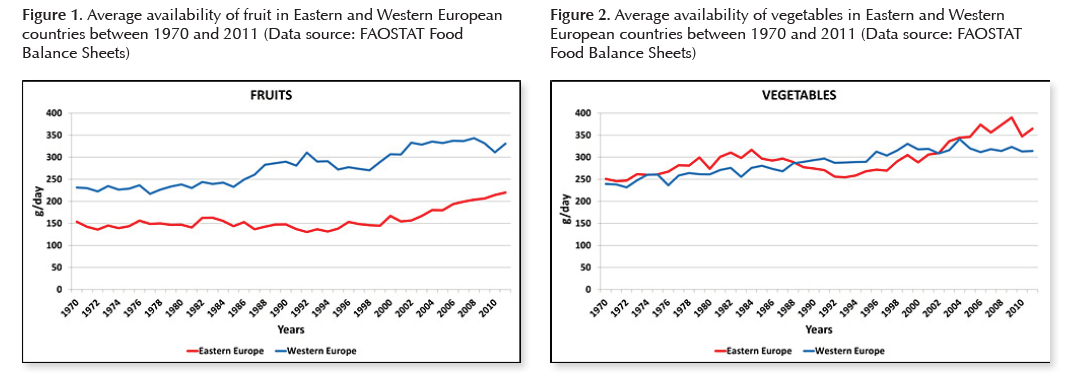Comparison of fruit and vegetable intakes between Eastern and Western European populations
Cardiovascular disease (CVD) mortality rates are substantially higher in Eastern compared Western European states. Difference in the consumption of fruit and vegetables between the two regions is a potential lifestyle factor which may contribute to this health gap. Due to methodological limitations, international comparison of individual-level dietary data from national food consumption surveys across European countries is not feasible. This systematic review assessed whether previously published cross-national studies with comparable dietary data on fruit and vegetable consumption reveal any systematic differences between populations of Eastern (including Central and Eastern Europe (CEE) and the Former Soviet Union (FSU)) and Western Europe.
Study design
Studies which reported data on fruit, vegetable consumption, or carotene and vitamin C intake of adult participants from both Eastern and Western European countries were considered for inclusion in the review. Only studies which applied the same methodology for data collection and analysis in both samples were included. Quality of the studies was assessed using a modified STROBE statement, and, in order to determine the statistical significance of the retrieved comparison results, power calculations were performed.
Lower intake of fruit in Eastern countries
Twenty-two studies met the inclusion criteria. All studies with adequate statistical power reported lower intakes of fruit in Eastern European participants compared to Western Europeans. Regarding the consumption of vegetables and antioxidants the findings were less consistent.
These results are accordant with ecological-level food availability data based on food balance sheets and household budgetary surveys. For example, comparison of average fruit and vegetable supply in Eastern and Western European countries between 1970 and 2011 shows clear difference only for fruit but not for vegetables (figures 1 and 2)1. Using individual-level dietary data, this systematic review suggests that availability patterns are reflected in actual consumption, and that people in Eastern European countries seem to eat less fruit than Western Europeans, while the difference in vegetable intake is probably less clear-cut.
Increase fruit intake to reduce the risk of CVD
As inadequate consumption of fruit is suggested as a modifiable risk factor for CVD, the difference in fruit intake may contribute to the gap in CVD mortality rates between Eastern and Western Europe. Dietary interventions which aim to increase fruit intake in Eastern European countries have good potential to reduce CVD burden in the region and decrease health inequalities across Europe.
Standardised dietary data to compare food consumptions across Europe
The reviewed studies included participants from many European countries and some of them provided nationally representative food consumption data. However, as there are large differences in fruit and vegetable intakes within the Eastern and Western European regions, the reported comparisons can only be seen as pixels of a much larger picture. The complete picture will emerge only when nationally representative, comparable dietary data is available for most European countries. In fact, this is the main aim of the European Food Safety Authority’s currently on-going “EU Menu” project2.

